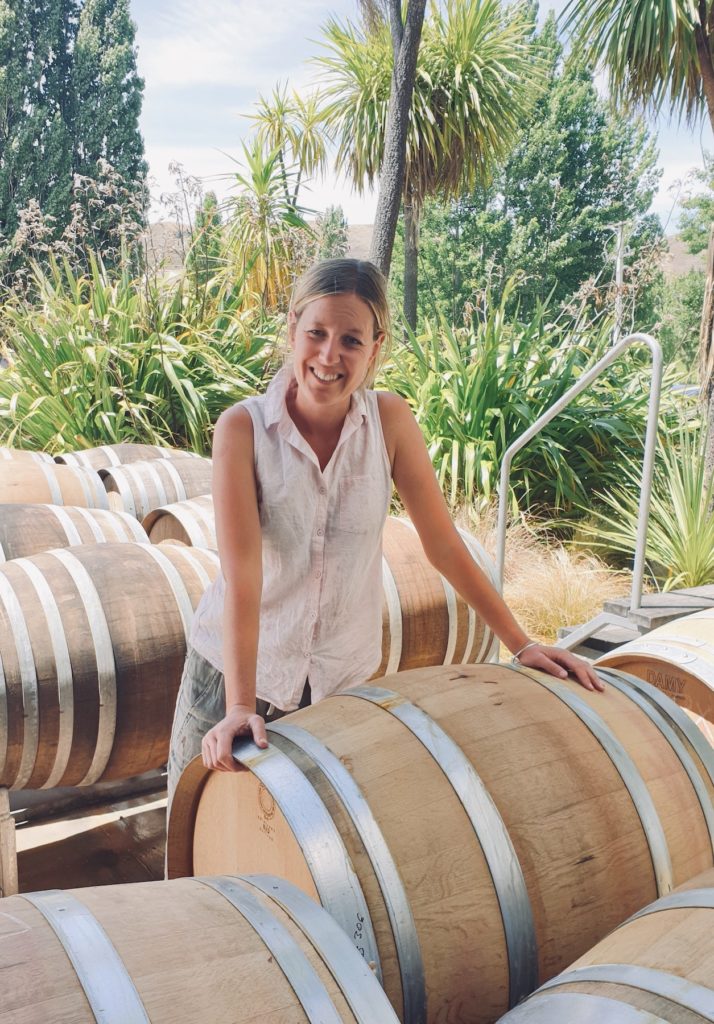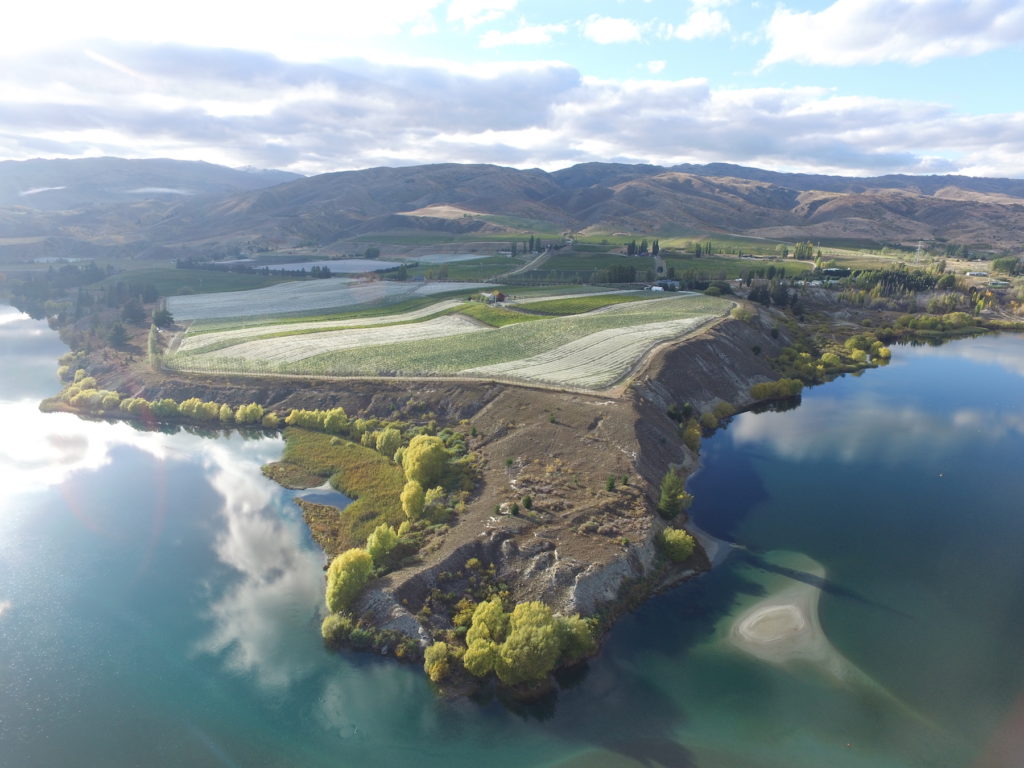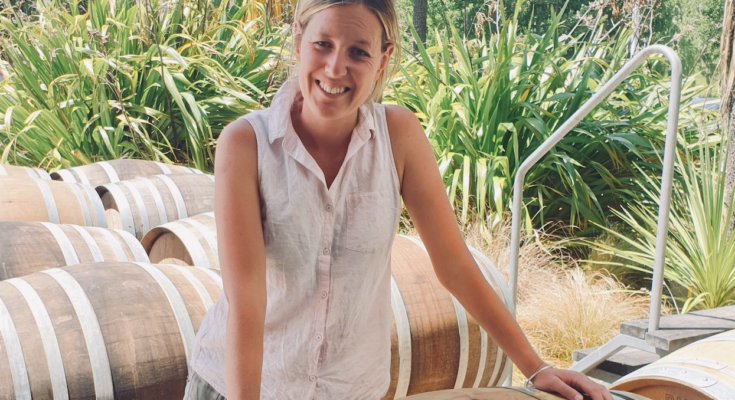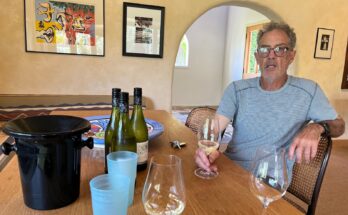Back to WineFolio’s most popular subject – the people creating New Zealand’s sensational wine! A visit to the beautiful Carrick vineyard and winery, and a chat with Rosie Menzies.

WineFolio: Tell me about Carrick – the place, the vineyards – and the wine. I know you make a few Pinots, including one from a single block?
Rosie Menzies: This site is incredibly beautiful. It’s almost like a peninsula – we’re surrounded by water – we have the Bannockburn inlet over here, and then the Kawarau River runs along the northern side of the vineyard. So we’re kind of on this little point. This site has incredibly sandy soils which were created from wind-blown glacial loess. The glaciers were formed in the Cromwell basin, and through their movement ground up the bedrock – which was then deposited here. That means our soils are well-draining, which is great for vines, but also means it’s really low on organic matter.
This was the first vineyard to be planted on Cairnmuir Road in Bannockburn. Steve and Barbara Green were the original owners and sold it about two years ago to our current owner Elizabeth Zhong. I started here about 15 months ago, after working in the wine industry around the world and NZ for the past 10 years. The 2020 vintage will mark my first harvest at Carrick as Chief Winemaker.
We’re well known for this sandy soil, and what it brings to the wines as well. They are quite structural wines – with firm tannin, but good acid, and we work with that and figure out how we manage that. One of the ways is through organic practices. We’ve been organically certified since 2011, and practising since 2008. In Central Otago there’s a strong focus on quality, and I think that goes hand in hand with Organic farming. Central Otago also has a strong identity – initiated by a bunch of pioneers who started out and paved the way for what we see now, where our wines are now recognised around the world.
You were asking about the single clone variety – this is the Abel Block here, and you can see the trellising looks quite different to the older plantings. Originally in Central Otago a lot of vineyards were set up with a high training cordon, no trellis and wide rows. Wide rows for tractors and high training because they felt that if you were higher off the ground, you reduced the risk of frost. But it’s not a great use of land. Everything we are doing here is by hand – from harvesting fruit to canopy management, we have a small crew dedicated to each task.
The vineyard has 24ha of vines planted, 19 hectares on this property and then just across the road we’ve got 5 more hectares – all within a tractor ride of the winery. Our winery is the perfect size for one person to manage throughout the year, with more during harvest. We make about 10,000 cases per annum, so relatively small. My favourite part of the winery is the barrel hall – it stays nice and cool – never gets more than 20 degrees, even on a really hot day. Being below the winery and restaurant allows us to fill the barrels by gravity. We bring in new French oak barrels each year, which account for no more than 20% of the Pinot blend, and with vine age we are looking to reduce this to about 10%. The barrel hall is split into two sides, allowing us to ferment the whites in barrel at a warmer temperature and leave the red barrel hall side cooler. Pretty much all of the whites, bar two, have an oak-fermented portion in them – anywhere from 100% to 30%.
Part of what we do here is to make a range of natural wines, which are made without any additives or preservatives, just grapes. We bottle on site by hand, to minimise the movement and handling of these wines. All are bottled under cork, and currently sitting here waiting to be labelled. We’ve got two Pinot Noir, and one Riesling, plus one co-fermented blend. The Billet Doux is our most popular Natural wine, we make around 380 cases. Making the natural wines is a good challenge to have as a winemaker and grows your understanding of how to reduce sulphur and other additions in our classic wines.

WF: You settling in to Central – is there a winemaking ‘scene’?
RM: Winemaking in Central is very collaborative and supportive. And has a strong community feel. There are many passionate people here who share a love for wine but also the land from which this comes. It is a strength drawn from the original pioneer days when the community was small, tight knit and didn’t have any option but to work together in order to sell their wine.
WF: Is there a point in the year where you get a ‘feeling’ for how it is going, or will go?
RM: I think there are points in the year where you can feel a shift, and you suddenly develop this bond with that wine.. But, for me, each wine that we make is a different process – you’re not just making it all the same – there’s no recipe. What we are trying to do here is allow the place to speak as clearly as possible. And obviously there are things you have to do as a winemaker to capture that. But doing less, can sometimes mean more in the wine.
What I love about wine is that it’s a constant learning process. I believe having a strong basis of scientific knowledge combined with curiosity and a desire to explore, helps to create an understanding of your place and your wine. The more that you know and understand, the easier it becomes to do less. Without that basis of understanding, doing nothing could be a problem.
WF: Is there a point in the year where you can see further down the line?
RM: The whites take longer, but certainly because the reds are so tactile – we wild ferment everything, so we let them do what they want. But simply because you are doing cap management/development on the reds during harvest, you get a daily feel for how they might be taking shape, and looking at those quite closely. Every wine that we make, there are decisions that you have to make around it.
With Pinot Noir, you’ll be tasting every day to look at the tannin structure and how that’s forming. That’s a balancing act. Then, with the white wines, we make a couple of off-dry styles as well – a Riesling and the Pinot Gris can have some sugar – and, again, it’s about finding that balance where the acidity and the sugars sit. With Chardonnay, we tend to work with two clones – mendoza and clone 6 – Clone 6 is up on the top terrace, and Mendoza is on the bottom terrace.
The vineyard is quite undulating, it kind of rolls down towards the river. Many vineyards around here, when they were established there were a lot of earthworks – that’s certainly what happened here. So we have these knuckles which are bare-boned, and then these shallows which are really rich, and a big difference between those two points. To me that’s not necessarily a bad point, to have subtle differences in your grape flavours adds to the complexity of your wine.
Because I’m relatively new to Carrick I’m still understanding the site. If you ask me the same question in five to ten years time, my answer might be different.

WF: Do you chase medals – win much at shows?
RM: No, not really. There was a little bit at the start with some shows, but the most recent one was the NZ Wine Awards in 2018 – we won the Best New Zealand Organic Red and Best New Zealand Organic White wine – with the Bannockburn Riesling and the Bannockburn Pinot Noir. That was great – in terms of providing some reinforcement about farming organically and showing that we are on the right track.
Our Estate Pinot Noir is from the oldest vines on the property, from the corner opposite the Cellar door – now 25 years old, all on their own roots. It spends about ten months in barrel with about 20% new oak. 2016 is pretty classic, our 2017 is a bit more bolshy and concentrated. The ’16 is a bit looser and aromatic. The way I see Pinot Noir is that it can be light and elegant on the palate, but have a density to its flavour and a depth as well. This (The Magnetic) is from a single block, single variety (Abel) and it is more fleshy, bold and giving.
We’re starting to change the labels slightly – we have introduced Organic to the front label, because we want to make it easy for customers to identify our wines as Organic.
Also, we work with a different painting of renowned artist Graeme Sydney each year for our Excelsior label.
He has been a strong supporter of Carrick over the years and in turn we help him out occasionally with his vineyard. He has a small plot near St Bathans, which is considered the highest altitude vineyard in Central Otago.
It is not easy to ripen grapes there, and over the past 10 years there have been two successful harvests.
WF: Do you have any favourite wines, or something you wished you could make?
RM: Barolo. So, Nebbiolo – I would love to have the opportunity to work with that; but it’s not something that you see that often in New Zealand. That would be a dream.





One Comment on “Winemaker series: Rosie Menzies”